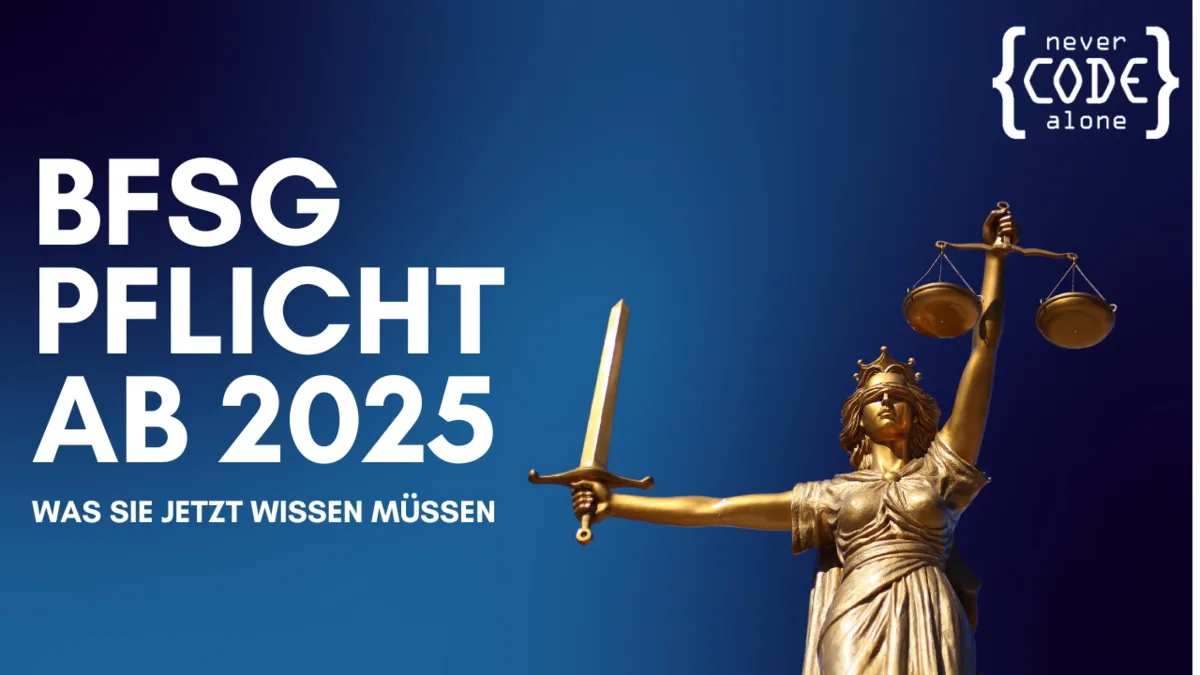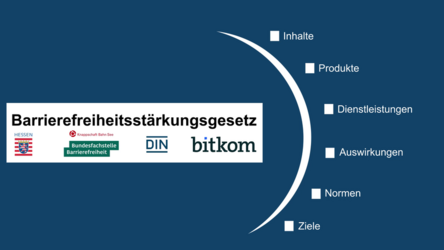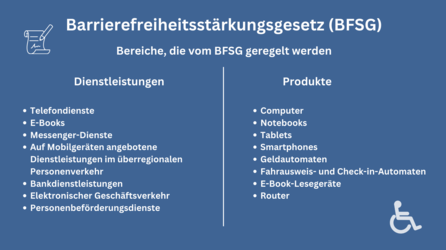
Table of contents
Web accessibility: mandatory from 2025 - What companies need to know now
A key regulation will come into force in 2025 with the Barrier-Free Accessibility Reinforcement Act (BFSG): companies will be obliged to make digital services accessible. But what exactly does this mean, why is it important and how can you as a company successfully implement the requirements? A comprehensive guide.
Accessibility: a social responsibility
Accessibility is more than just a legal obligation - it is a fundamental right. Around 13 million people in Germany live with permanent or temporary impairments. They often encounter unnecessary hurdles when they want to use digital services. Imagine trying to use a website with your eyes closed. This is exactly the reality that many affected people experience every day. Accessible websites not only enable participation, but also strengthen user loyalty and your brand.
What does the Accessibility Reinforcement Act require?
The BFSG sets binding standards for companies that need to make their digital offerings more accessible. The international standard WCAG (Web Content Accessibility Guidelines) forms the central basis. Your website or app is considered accessible if its content and functions can be used by people with different disabilities - whether through alternative displays for the visually impaired, easy-to-use navigation or the avoidance of elements that could potentially trigger epileptic seizures.
Who is affected?
The requirements will apply from June 2025 for companies that offer digital services or products to end consumers. This includes:
- Online shops,
- e-commerce platforms with support functions,
- mobility and telecommunications providers.
Small companies with fewer than 10 employees and an annual turnover of less than two million euros are excluded. Pure presentation sites or private blogs without commercial content are also not subject to the obligation.
What are the consequences of non-compliance?
Companies that ignore the new requirements expose themselves to considerable risks:
- Fines: Fines of up to 100,000 euros.
- Warnings: Competitors and consumer protection organisations can report infringements.
- Market access bans: The market surveillance authorities can withdraw non-accessible products from the market.
How do you achieve accessibility?
Switching to accessible digital services requires strategic action and technical expertise:
- Analysis: Check the status quo of your website. Tools such as the NVDA screen reader help to identify weak points.
- Implementation: Work with experienced developers and UX designers to design accessible content and functions. This includes, among other things:
- Alternative text for images,
- sufficient contrast for texts,
- easy-to-use navigation elements.
- Testing: Test the changes with different target groups and assistive technologies to ensure accessibility.
- Continuous improvement: Accessibility is not a state, but an ongoing process. User feedback and regular audits are essential.
Why accessibility is also an SEO benefit
Accessibility not only improves the user experience, but also increases the visibility of your website in search engines. Clear structures, semantically correct HTML and descriptive metadata are favoured by search engines and boost your SEO performance in the long term.

Reach our specialists for accessible web design
We are here to help you. Together we can master your digital challenges and promote inclusion on the Internet. Let us make your projects successful with accessible web design.
Conclusion: Accessibility is not a "nice-to-have"
Accessibility will be mandatory from 2025, but companies should not just see this as a regulatory requirement. An accessible website strengthens your brand, increases reach and opens up your offerings to all people equally. There may be technical challenges along the way, but the benefits - legal, economic and ethical - far outweigh them.
Act now to help shape the future - barrier-free and accessible for all.
Picture gallery BFSG Duty 2025
In this picture gallery you will find various illustrations on the subject of accessibility and the Accessibility Reinforcement Act.

Eine Infografik mit dem Titel "Barrierefreiheitsstärkungsgesetz". Das Bild zeigt die Logos verschiedener Organisationen wie "DIN" und "Bitkom" sowie Stichworte wie "Inhalte", "Produkte", "Dienstleistungen", "Normen" und "Ziele", die den Anwendungsbereich des Gesetzes darstellen.

Eine Übersichtsgrafik mit einer Auflistung der Bereiche, die das BFSG regelt. Auf der linken Seite sind Dienstleistungen wie Telefondienste, E-Books und Bankdienstleistungen aufgelistet, auf der rechten Seite Produkte wie Computer, Smartphones und Geldautomaten. Am unteren Rand befindet sich ein Rollstuhl-Symbol.

Ein moderner Arbeitsplatz in einem sonnendurchfluteten Büro. Auf einem großen Monitor ist die Überschrift "BFSG Guide 2025" zu sehen, umgeben von Symbolen, die Barrierefreiheit und Inklusion darstellen, wie das Rollstuhl-Symbol, Gebärdensprach-Symbole und visuelle Indikatoren. Der Schreibtisch ist mit technischen Geräten und einer Pflanze dekoriert.

Ein Infografik-Bild mit blauer Hintergrundfarbe, das die Anforderungen des Barrierefreiheitsstärkungsgesetzes (BFSGV) erläutert. Darunter fallen bedienbare Identifizierungs- und Sicherheitsfunktionen, die Bereitstellung von Informationen über mehrere sensorische Kanäle, angemessene Schriftgrößen und Kontraste sowie alternative Darstellungen für visuelle Inhalte.

Eine Junges, gemischtes Team von Webdesignern als Cartoon-Darstellung arbeitet in einem Büro an der Umsetzung des Barrierefreiheitsstärkungsgesetz.
Frequently asked questions (FAQ)
What are accessible websites?
Accessible websites are digital offerings that are accessible and usable for all people - regardless of physical, sensory or cognitive limitations. This includes features such as clear navigation, alternative text descriptions and sufficient contrast.
Who does the Barrier-Free Accessibility Improvement Act (BFSG) apply to?
The law applies to companies that offer digital products or services to consumers, such as online shops, telecoms providers and mobility services. Small companies with fewer than 10 employees and an annual turnover of less than two million euros are exempt.
What deadline do companies have to meet?
From 28 June 2025, affected companies must ensure that their websites, apps and digital products comply with the requirements of the BFSG.
What requirements must websites fulfil according to the BFSG?
The BFSG is based on the international standards of the WCAG (Web Content Accessibility Guidelines). These stipulate that digital content and functions must be accessible and usable for all people. Important requirements include barrier-free navigation, alternative displays for non-textual content (e.g. image descriptions), compatibility with assistive technologies such as screen readers and the avoidance of elements that could potentially trigger health risks such as epileptic seizures.
What are the penalties for non-compliance with the BFSG?
Companies that do not fulfil the requirements of the Barrier-Free Accessibility Reinforcement Act (BFSG) expose themselves to considerable legal and financial risks. Violations can result in fines of up to 100,000 euros, which can be imposed by the responsible market surveillance authorities. There is also the possibility that competitors or consumer protection organisations will issue warnings, which are not only costly but can also damage a company's reputation. In particularly serious cases, the market surveillance authority can even order that the affected products or services may no longer be offered until accessibility is guaranteed. These consequences make early implementation of the legal requirements essential.
What are the advantages of an accessible website?
An accessible website offers numerous advantages that go beyond mere compliance with legal requirements. On the one hand, accessible digital offerings improve the user experience for everyone, as they impress with clear navigation, easy-to-read content and intuitive operation. This increases customer satisfaction and loyalty. Secondly, you expand your reach by including a larger target group, including people with disabilities or temporary restrictions. This not only strengthens your brand, but also positions your company as socially responsible. Another important benefit is improved SEO performance: accessible websites are often better structured and use semantically correct HTML code, which is favoured by search engines. This increases the visibility of your website in search results.
How do I check whether my website is accessible?
You can use tools such as the NVDA screen reader to test your website for barriers. Regular audits by experts are also advisable to ensure compliance.
Does the BFSG also apply to the B2B sector?
The law is primarily aimed at offers for end consumers (B2C). Pure B2B offers are excluded, unless consumers can access the services.
Can I implement accessibility myself, or do I need external help?
Implementation requires technical expertise and experience in the field of UX/UI. For correct implementation, it makes sense to work together with web developers and accessibility experts.
What steps are necessary to achieve accessibility?
The path to an accessible website begins with a thorough analysis of existing content and functions to identify potential barriers. This is followed by planning an implementation strategy where you prioritise which changes need to be made. The technical implementation requires collaboration with experienced UX/UI designers and developers to ensure the website is accessible to all users. Finally, comprehensive testing with assistive technologies and feedback from affected users should be obtained to ensure the effectiveness of the measures.
